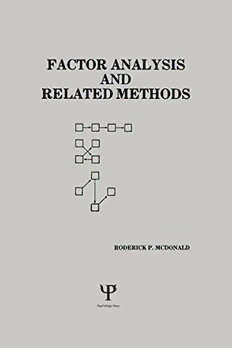Table Of ContentFactor Analysis
and Related Methods
229*152HB
This page intentionally left blank
FACTOR ANALYSIS
AND
RELATED METHODS
RODERICK P. MCDONALD
Macquarie University
New South Wales, Australia
First Published 1985 by Lawrence Erlbaum Associates, Inc.
This edition published 2014 by Psychology Press
711 Third Avenue, New York, NY, 10017
and by Psychology Press
27 Church Road, Hove, East Sussex, BN3 2FA
Psychology Press is an imprint of the Taylor & Francis Group, an informa business
Copyright ©1985 by Lawrence Erlbaum Associates, Inc.
All rights reserved. No part of this book may be reprinted or reproduced or
utilised in any form or by any electronic, mechanical, or other means, now
known or hereafter invented, including photocopying and recording, or in any
information storage or retrieval system, without permission in writing from
the publishers.
Trademark notice: Product or corporate names may be trademarks or
registered trademarks, and are used only for identification and explanation
without intent to infringe.
Library of Congress Cataloging in Publication Data
McDonald, Roderick P.
Factor analysis and related methods.
Bibliography: p.
Includes index.
I. Social sciences—Statistical methods. 2. Factor
analysis. I. Title.
HA29.M4385 1985 300'.28 84-21157
ISBN 0-89859-388-3
ISBN 978-1-315-80251-0 (ebk)
Contents
Preface ix
1. Introduction 1
1.1 Aims of the Book 1
1.2 Review of Basic Concepts 3
1.3 Multiple Regression Theory: The Foundation of Factor Analysis 14
1.4 Some Basic Multivariate Hypotheses 20
1.5 The Key Concepts of Common Factor Analysis 28
1.6 Mathematical Notes on Chapter 1 41
2. Exploratory Common Factor Analysis 50
2.1 The Parameters of the Common Factor Model 50
2.2 Estimation 52
2.3 Component Theory, Image Theory, Approximate Methods, and
Heywood Cases 62
2.4 Devices for Approximating Simple Structure 81
2.5 Related Methods 88
2.6 Mathematical Notes on Chapter 2 93
3. The Analysis of Covariance Structures: Confirmatory Factor
Analysis and Pattern Hypotheses 96
3.1 Introduction 96
3.2 Confirmatory Factor Analysis 99
v
Vi CONTENTS
3.3 Pattern Hypotheses and Parallel Tests 107
3.4 Mathematical Notes on Chapter 3 110
4. Models for Linear Structural Relations 113
4.1 Causal Relations and Causal Modeling 113
4.2 McArdle’s Model for Linear Structural Relations 127
4.3 Mathematical Notes on Chapter 4 151
5. The Problem of Factor Scores 156
5.1 Factor Analysis as a Test Construction Device 156
5.2 The Estimation of Common Factors 157
5.3 The Indeterminacy of Common Factors 165
5.4 Mathematical Notes on Chapter 5 168
6. Problems of Relationship Between Factor Analyses 171
6.1 The Comparison of Separate Analyses 171
6.2 Simultaneous Factor Analysis in Several Populations 180
6.3 Repeated-Measures Designs 188
7. Item Response Theory 198
7.1 The Problem of Binary (Dichotomous) Data 198
7.2 Item Response Theory— Latent Trait Theory 202
7.3 Factor Analysis and Test Theory 214
8. Summary 223
8.1 Introduction 223
8.2 Exploratory Common Factor Analysis 225
8.3 The Analysis of Covariance Structures 227
8.4 Models for Linear Structural Relations 227
8.5 The Problem of Factor Scores 229
8.6 Problems of Relationship Between Factor Analyses 230
8.7 Item Response Theory 231
Appendix— Some Matrix Algebra 232
A.1 Matrices, Vectors, Scalars 232
A.2 Matrix Equalities, Sums and Differences 234
CONTENTS Vii
A.3 Multiplication— Length of a Vector 235
A.4 The Trace of a Matrix 238
A.5 Special Matrices 240
A.6 The Inverse of a Matrix 243
A.7 Determinants 244
A.8 Partitioned Matrices 245
A.9 Expected Values 246
References 249
Author Index 253
Subject Index 255
TO AVIS
PETER, CHRISTINE, AND STEPHANIE
AND IN MEMORY OF MY PARENTS
Preface
This book is a revision and expansion of a set of chapters on factor analysis
written in 1975 while I was on study leave in the Department of Psychology,
University College, London. These chapters have been used as course notes for
postgraduate classes in factor analysis at the Ontario Institute for Studies in
Education over a number of years, and the reactions of my students have helped
to guide the process of revising and completing the text.
It is hoped that the book will serve both as a textbook for postgraduate and
advanced undergraduate students in the social sciences and as a reference book.
In writing the book, I have tried to imagine, as the reader, a student or worker
in one of the social sciences who wishes to be able to read studies using factor
analysis and perhaps to do research using factor-analytic methods, with technical
advice, but who does not wish to learn the mathematics of factor theory. (The
term social science is here interpreted widely to include economics, behavioral
science, and education.) Specifically, I disciplined myself not to use any matrix
algebra or multivariate statistical theory in the body of the text. An account of the
elements of matrix algebra (in the appendix and in the mathematical notes at the
ends of the chapters) can be skipped without any sense of discontinuity or loss,
but they would be helpful to the reader who wishes to make a transition to more
advanced treatments of these topics and could also deepen understanding of the
account in the main text. An attempt has been made to use verbal expressions to
describe what are basically mathematical concepts in such a way that they will
have an intuitive meaning for the nonmathematical reader, while not appearing to
be shamefully lacking in rigor from the point of view of a mathematician. Others
may judge the success of this attempt.
It has to be admitted frankly that in contrast to some other areas of research
method (e.g., the main body of univariate statistical methods) factor analysis, in
ix

